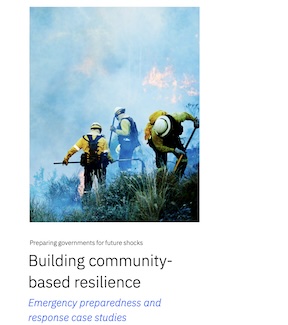
Rethinking Resilience: Empowering Communities for Crisis Preparedness

In an era marked by increasingly frequent and complex disasters—from fires and floods to infrastructure failures and humanitarian emergencies—governments around the world grapple with the limitations of traditional, centralized response models. A new report, Building Community-Based Resilience, from the IBM Center, the IBM Institute for Business Value, and the National Academy of Public Administration, offers a compelling call to action: governments must build resilience from the ground up, and in collaboration with strategic partners.
This report, produced based responses to a challenge grant competition for compelling approaches to crisis preparation and response, represents the latest in a multi-year IBM-NAPA Future Shocks Initiative to help governments build capacity for addressing and emerging stronger from disruption.
A New Paradigm for Emergency Preparedness
This report -- the third in a series exploring innovative approaches to preparing for and responding to crises in a variety of domains -- emphasizes that the ability to safeguard lives and sustain essential services during high disruption depends on empowering local communities with the authority, resources, and information to act swiftly and decisively.
Rather than relying solely on top-down directives, the report recommends a distributed model of resilience that places decision-making power and critical assets closest to the point of impact. This approach not only reduces chances for bottlenecks, but also accelerates recovery and enhances coordination across systems and borders to accelerate recovery and strengthen public trust.
Insights from Real-World Case Studies
Drawing on four diverse case studies—which highlight local government action from California’s fire-prone neighborhoods to the United Kingdom’s emergency communications overhaul—the report illustrates how embedded local capacity, interoperable systems, and pre-disaster partnerships can transform response to shocks in multiple settings. These cases include:
- California’s Community Brigades show how trained neighborhood teams can extend firefighting capacity and build trust between citizens and responders.
- Texas’s BeforeDuringAfter.com consolidates over 10,000 local resources into a single platform, offering small businesses tailored guidance before, during, and after disasters.
- Florida DOT’s Resilience Action Plan uses scenario planning tools and standardized data to help local agencies anticipate and mitigate infrastructure risks.
- The UK’s Emergency Services Network integrates secure communications across police, fire, and ambulance services, ensuring coordination when it matters most.
These examples underscore that resilience cannot be viewed as a passive trait—governments must adopt resilience as a deliberate strategy to serve their constituents.
Four Imperatives for Leaders
To help public sector leaders translate these lessons into action, the report concludes with a Leadership Action and Readiness Guide, outlining four imperatives:
- Distribute operational capacity to the point of impact – Equip local teams with the authority and resources to act independently in the critical first hours.
- Make actionable information universally accessible – Build interoperable systems that ensure all responders have access to real-time, location-specific intelligence.
- Institutionalize forward-looking, data-driven planning – Use predictive modeling and standardized hazard data to inform long-term decisions.
- Build integrated networks that function under stress – Forge cross-sector partnerships and test systems regularly to ensure they hold under pressure.
The Guide pairs each imperative with self-check questions to help leaders assess readiness and identify gaps, which can determine the success or failure of response efforts.
A Call to Act Before the Next Crisis
Governments must anticipate crises and respond with proactive, community-embedded preparedness. The report does not just reflect past challenges—it presents a roadmap for to build a safer, more resilient future.



